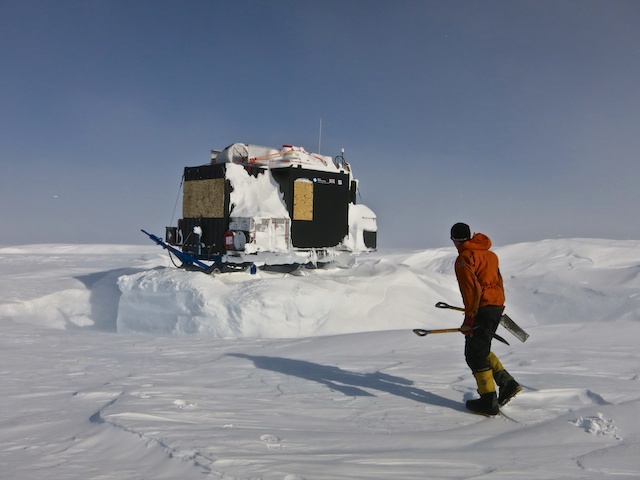ANTARCTIC BLOG: Polar guide arrives on site #5
2 December, 2015 Flichner Ice Shelf
As we finally approached our input site I could see our future home in the distance, a little black dot on a frozen white ocean, slowly growing in size as we flew towards it. Our home was to be a converted shipping container called a caboose. 14 meters squared for four men for three months.
As we got closer to our site I could see the Pisten Bullies and cargo sledges all on the surface, a great relief and a lot of gratitude was felt to the previous seasons Traverse Leader for doing such a good job making our lives easier this year. All the equipment is left in-situ over the Antarctic winter. The drifting snow, which I like so much, also causes us a lot of problems as it accumulates and over time, literally buries anything left on the surface. To avoid the vehicles, caboose, cargo and fuel being buried over winter they are placed on ‘berms’ at the end of each season. Orientated into the prevailing wind, berms are big banks of snow up to three meters high built using the PB’s. The equipment is then driven on top of them and winterised above the surface. Despite berming it has been known for equipment and PB’s to be totally buried and cabs full with snow when returning the next season on some parts of the continent, but lessons have been learned and we were happy to find our traverse unit easily accessible.

BB King landed and stuck around long enough for us to set-up our radio and check that the stove worked. Once that was done it was time for him to leave as he had a long flight back to base ahead of him, nearly a thousand nautical miles. The first thing for us to do was to put the kettle on and make a cup of tea and think about setting up camp, during which we received a trade-mark low pass from BB King as a gesture of goodbye, good luck (and a bit of “look at me!”).
It took us nearly a week to set-up. There was still a lot of digging to be done and reshuffling of equipment on the fifteen tonne Lehman sledges to make room for more equipment coming our way. The AWI mechanics set to work on getting the vehicles started, each machine looking like it was on some kind of life support with generators charging the batteries and space heaters warming up the engine bay and another generator plugged in to heat up the engine oil. I had to laugh at one moment when Sverrir (AWI Mech.) was squatting beside the PB with a piece of bamboo trying to remove snow from the fan belt.
“All of this hi-tech equipment, all of this world-class science and we’re still just apes poking at things with sticks!” I thought to myself.
After a couple of days the first machine was ready to drive off the berm. Stiff from the cold, it groaned and creaked and slowly moved forward breaking through snow drifts until it was free and ready to go. Complete with an integrated crane and its blade able to move 5 tonnes of snow at a time, life became a lot easier from that moment on.
One of the reasons PB traverses are used is because of the amount of fuel they can tow which is delivered by ship saving money on flights. All of the fuel needed to be pumped from bladders stored on berms into bladders stored on plastic sledges which can be dragged along the snow with the PB’s. In total we are towing over 34000 litres of fuel which is used to refuel aircraft, power the hot water drill for the Oceanographers and of course to fuel the PB’s. Once the ‘poly’ sledges, Lehman sledges and caboose were ready and loaded it was time to link it all together in two long trains, in total weighing approximately 56 tonnes (not including the weight of the vehicles). Once it was all linked together there was nothing left to do but drive to our rendezvous point with the AWI Basler; Polar 5, 75km away.
After a full day of driving we chose a suitable area that we could use to groom and piste a skiway. Another two days of setting up and we were ready to receive more cargo before our planned move to the first drill site on the Filchner 300km away. However that was over ten days ago and we have still not had the Polar 5 come to visit. Stress, pressure, physical hardship, risks; these things are enjoyable. The real challenge of the Antarctic comes with playing the waiting game.
Field Guide Ashly Fusiarski is supporting the Filchner Ice Shelf System project which aims to determine how a large sector of the Antarctic Ice Sheet will evolve in a warming world.